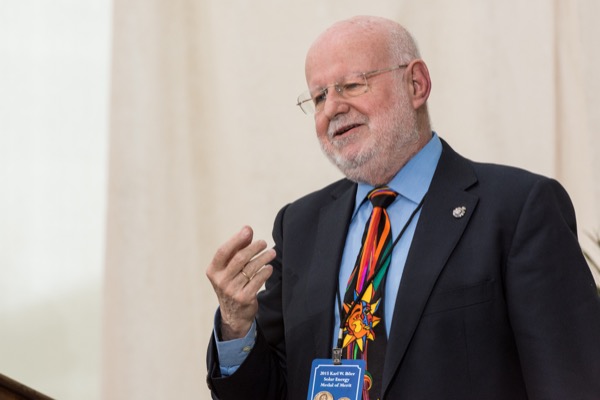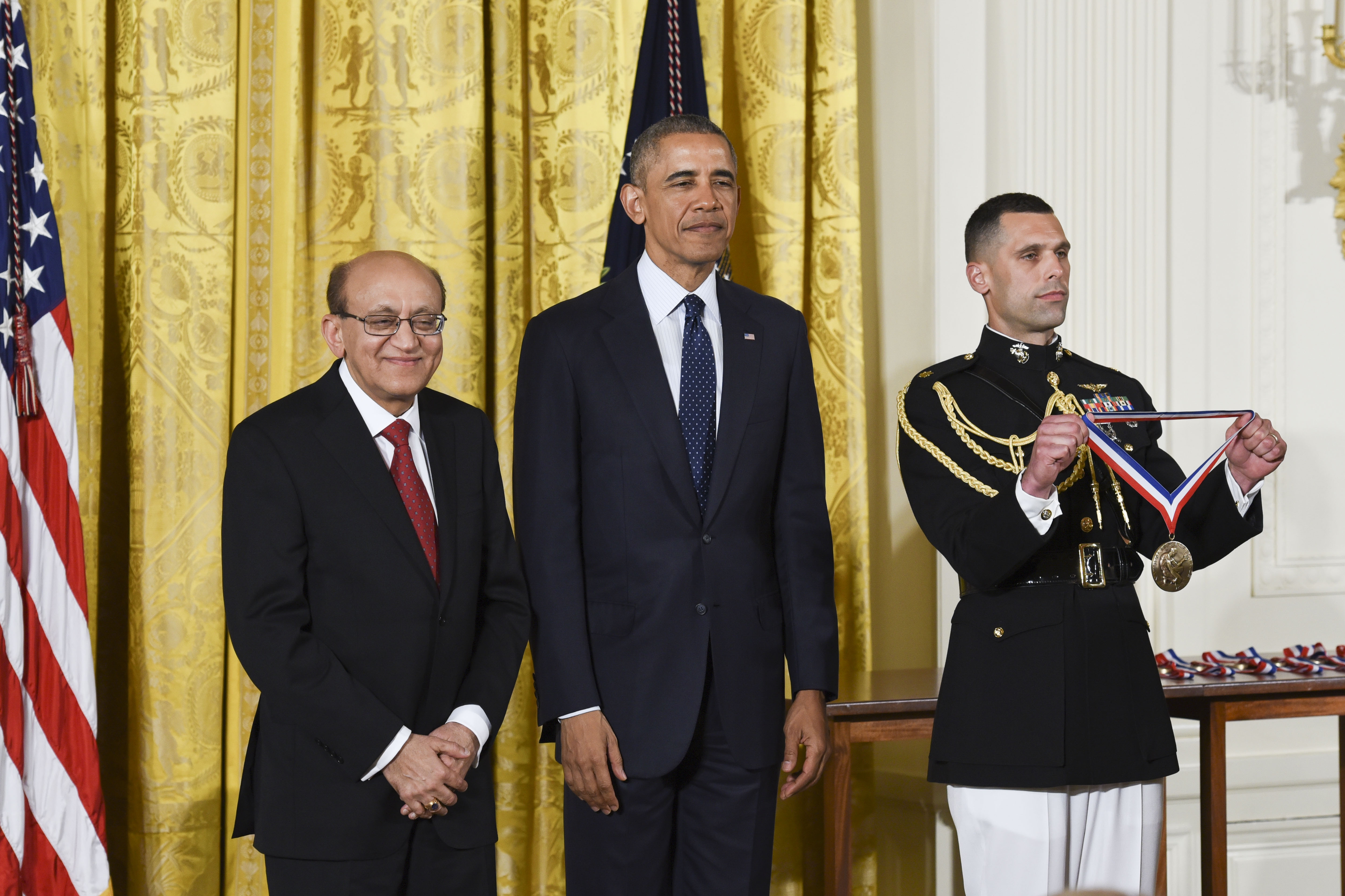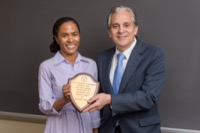


Karl Bӧer Award
Solar pioneer Luque receives Bӧer Medal of Merit during ceremony at UD
1:52 p.m., March 17, 2015--Long before it was popular or anyone attached the color "green" to sustainable ways of living on Earth, Antonio Luque was carrying a torch for solar energy.
An expert in photovoltaics -- the business of converting the sun's energy into electricity -- and founder of the Institute of Solar Energy in Madrid, Spain, Luque was recognized at the University of Delaware Friday with the 20th Karl W. Bӧer Solar Energy Medal of Merit.
Honors Stories
National Medal of Science
Warren Award
The award, which carries a $60,000 prize and is made every two years, recognizes those who have made significant contributions in the field of renewable energy. It is named for the longtime UD professor and solar cell scientist who founded the University's Institute for Energy Conversion.
Luque's research, inventions and winsome ability to build interest and global partnerships all were noted as pivotal in the development and expansion of solar energy use around the world. Luque said Bӧer's book, Survey of Semiconductor Physics, was inspiring to him.
Bӧer presented the medal to Luque with a surge of emotion and a bit of self-revelation.
"People know that I am very critical," Böer said, "and I'm very careful in using praising words."
But, Böer said to Luque, "You know how to do things, over and beyond what you have learned from us.... You have moved your nation to the top of the renewable energy field and you have done this with an enthusiasm which up to today I admire. Aren't we lucky to have you?"
Among Luque's contributions to the field were the invention of intermediate band solar cells, which increased efficiency by more than 20 percent (from 41 to 63 percent), and new solar cells called bifacial silicon solar cells that captured light on both sides -- one side capturing direct light, the other capturing reflected light.
Challenges remain, Luque said, and the biggest is improving storage options so that solar energy remains available even when the sun is not shining. But he sees a bright future for photovoltaics as many scientists work to increase efficiency and storage while continuing to reduce costs. He said he had spoken with a young UD professor who was doing promising work. Luque said he hoped to study that professor's idea closely.
"Solar is the only sustainable source of energy we can count on," Luque said. Coal, uranium, oil and gas have limitations, he said, and all involve "unbearable wastes."
A photovoltaic plant built in Spain in 2008 can generate 2.5 gigawatts of power -- 2.6 billion watts, that is -- about as much as a medium-sized nuclear plant, Luque said. By contrast, a nuclear plant requires about 10 years to install, he said.
Solar energy has emerged as a "vibrant" commercial industry, now approaching 200 gigawatts of installed capacity worldwide, according to David Renné, president of the International Solar Energy Society, which was formed in 1954 to promote renewable energy. The society embraces the idea that renewable energy could one day represent 100 percent of the world's electricity generating capacity if sufficient support and technology emerge, he said.
At UD, solar panels around the campus are generating more than 1 million kilowatt hours of electricity every year, University President Patrick Harker said.
But while capture and consumption of solar energy continue to increase, it remains a little-used resource compared to most other power sources because of storage problems.
According to a draft report of the U.S. Energy Information Administration, the use of solar power more than tripled in the U.S. from 2009 through 2013, but remained fourth among five renewable energy sources overall, with biomass (wood, biofuels and waste) power at the top of the list, hydroelectric power second, wind third, and solar and geothermal energy rounding out the list.
Globally, it represents about 1 percent of the world's electricity generating capacity, Renné said.
Luque believes the role of solar energy will -- and must -- expand. And he has been a tireless ambassador for photovoltaics, according to Steven Hegedus of the Institute of Energy Conversion, who collaborated with Luque as co-editor of the field's classic Handbook of Photovoltaic Science and Engineering.
The sun's energy is plentiful. The photovoltaic technology -- capturing solar energy and converting it to electricity -- is sustainable. And solar now is "marginally cost-effective" for wholesale distribution, Luque said. Ultimately, he said, it will be cheaper than other alternatives.
Storage remains the big challenge, Luque said. He sees interesting possibilities in some unusual approaches -- molten silicon storage and thermo-photovoltaic conversion, for example.
"It is now widely accepted and discussed by the solar trade magazines, reports from national research labs, and worried utility executives alike that ability to store electricity generated by solar and wind is essential to its widespread integration into the grid," Hegedus said later in an email.
The peak of solar production is around 11 a.m. to 3 p.m., Hegedus said, while peak demand goes from about 4 p.m. to 9 p.m., depending on location. Without better storage, the use of solar energy won't rise above 5-10 percent of the grid. But even a few hours of additional storage capacity could double that usage to 10-20 percent, he said.
"Saving it for later with on-site storage, either in batteries or more unusual forms like the molten silicon that Luque mentioned, helps smooth out demand peaks due to increased air conditioning and household usage in the early evening when every one comes home from work," he said.
Article by Beth Miller
Photos by Evan Krape










